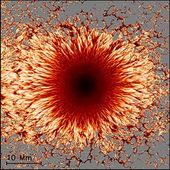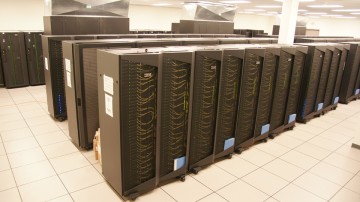
© Matthias Rempel, NCARThe interface between a sunspot's central and outer regions shows a complex structure.
First model of entire sunspots shows striking, beautiful detail.
In a breakthrough that will help scientists unlock mysteries of the sun and its impacts on Earth, scientists have created the first-ever comprehensive computer model of sunspots. The resulting visuals capture both scientific detail and remarkable beauty. The results are published this week in a paper in
Science Express. The research was supported by the National Science Foundation (NSF).
The high-resolution simulations of sunspots open the way for scientists to learn more about the vast mysterious dark patches on the sun's surface, first studied by Galileo. Sunspots are associated with massive ejections of charged plasma that can cause geomagnetic storms and disrupt communications and navigational systems. They are also linked to variations in solar output that can affect weather on Earth and exert a subtle influence on climate patterns.

